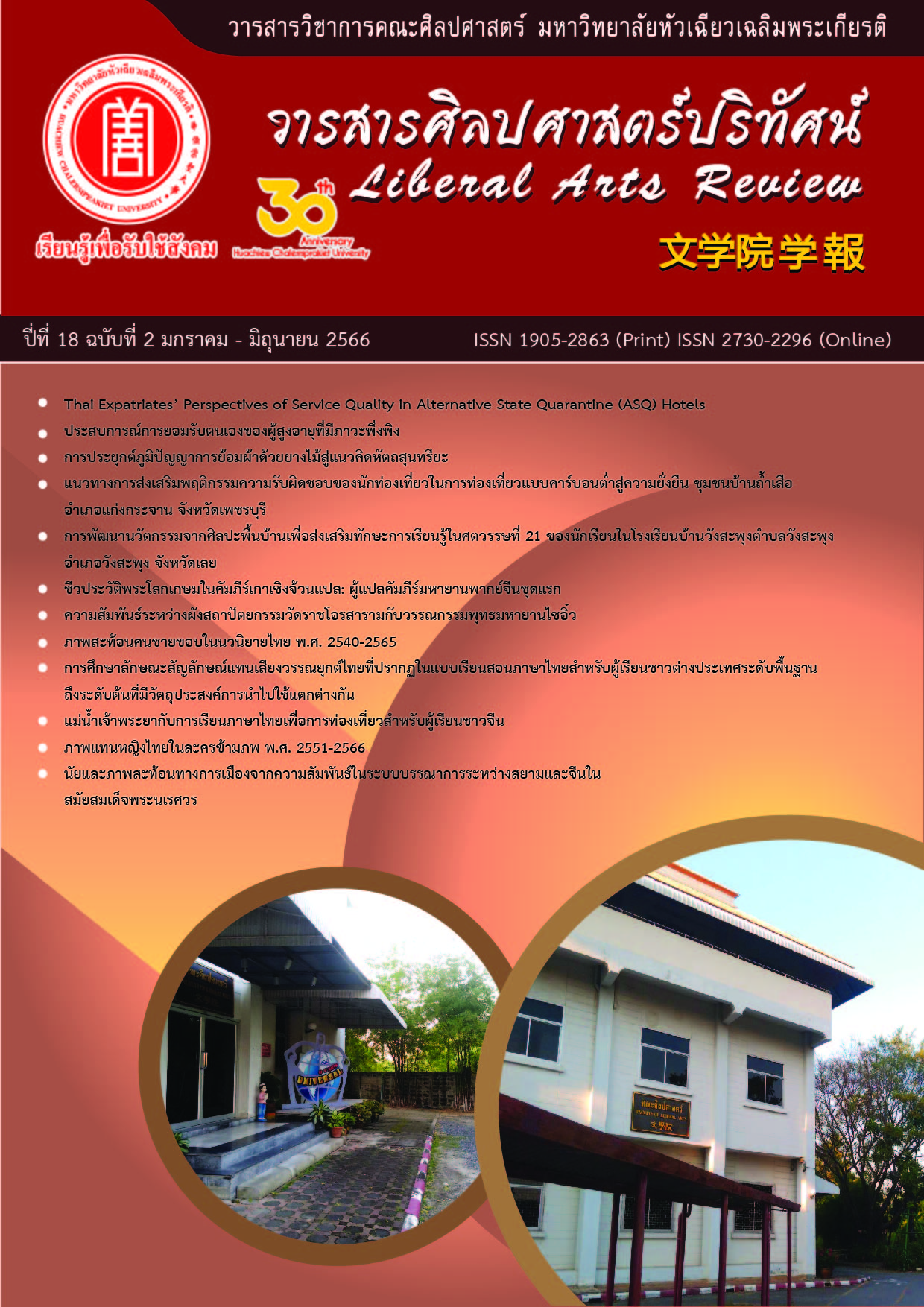Apply the Wisdom of Fabric Dyeing With Resin to Aesthetically Pleasing Handicrafts
DOI:
https://doi.org/10.14456/lar.2023.12Keywords:
Apply the Wisdom, Resin, Dyeing process, Natural pigment, Aesthetic, Aesthetically Pleasing HandicraftsAbstract
This research article utilizes traditional fabric dyeing handicrafts in application with resin. From research, the resin has the properties of natural glue with a chain of carbohydrate molecules that are adhesive and water-insoluble. This molecular structure resembles carbohydrates in the flour used to manufacture bioplastics in food coatings, packaging, clothes, et cetera. The researcher foresees this resemblance of properties, hence adapting resin to create bio-resin (resin) that can coat natural dye, allowing better adhesion to the fabric threads. Also, resin or Karaya Gum, is an acid acting as an emulsifier, so it could likewise support synthesis of the bio-resin. The fabric dyeing process with resin is water-saving, consequently reducing water pollution by-products. Furthermore, the researcher found that applying the wisdom of fabric dyeing with resin promotes handicraft aesthetics (hand, head, heart) in the creativity of hand-dyed fabric. There are three fabric dyeing guidelines: 1) The creativity of being conscious of the environment. 2) The creativity of rational thinking from nature. 3) The creativity of self-dependence to discover a moment of mindfulness.
References
สำนักงานฝ่ายบริหารการตลาดและรับจ้างผลิตสินค้า (กลุ่มเกียรติ์พสุธาร). (ม.ป.ป.). ค้นคืนจากhttps://www.marketingoemoffice.com/Data_Karaya_Gum.html.
เก่ง กิติเรียงลาภ, บรรณาธิการ. (2564). ANTHROOCENE บทวิพากษ์มนุษย์และวิกฤตสิ่งแวดล้อมในยุคสมัยแห่งทุน กรุงเทพมหานคร: ศูนย์มานุษยวิทยาสิรินธร (องค์การมหาชน).
จักร พิชัยศรทัต. (2566). การย้อมผ้าด้วยสีจากธรรมชาติ (พิมพ์ครั้งที่ 4). กรุงเทพมหานคร: สถาบันสรรค์งานศิลป์.
จินตนา บุพบรรพต, สมภพ รัตนประชา, มานพ ผู้พัฒน์, จิณนา เผือกนาง, และ อภิสิทธิ์ ด่านชูธรรม. (2556). การอนุรักษและใชประโยชนไม้วงศยาง. กรุงเทพมหานคร: สำนักวิจัยการอนุรักษ์ป่าไม้และพันธุ์พืช กรมอุทยานแห่งชาติ สัตว์ป่า และพันธุ์พืช.
ธนาคารแห่งประเทศไทย. (2543). เงินตราล้านนาและผ้าไทย. กรุงเทพมหานคร: อมรินทร์พริ้นติ้งแอนด์พับลิชชิ่ง.
ธีรพล อิ่มใจ. หัวหน้าสาขาเซรามิกส์ (26 ตุลาคม 2565). สัมภาษณ์.
ปรีชา มูลสิน, ทันทิรา พันชารี, และกนกกรณ์ ศิริทิพย์. (2564). การศึกษาการย้อมสีธรรมชาติจากใบยางพารา โดยใช้สารส้ม จุนสี และสนิมเหล็กเป็นสารช่วยติดสี. วารสารมหาวิทยาลัยราชภัฏร้อยเอ็ด: วิทยาศาสตร์และเทคโนโลยี, 2(1), 35-36.
พระเกษมพันธ์ สุธีโร (ตรงสุรีย์พร). (2561). แนวคิดการยอมรับของมนุษย์ในทัศนะของอัลแบร์ กามูส์. ศิลปศาสตร์ปริทัศน์, 13(25), 131-140.
ไพรัตน์ ปุญญาเจริญนนท์, กาญจนา ลือพงษ์, และจำลอง สาริกานนท์. (2557). การพัฒนาการเตรียมสีผงจากการย้อมธรรมชาติ: งานวิจัยคณะสิ่งทอและออกแบบแฟชั่น. กรุงเทพมหานคร: มหาวิทยาลัยเทคโนโลยีราชมงคลพระนคร.
วทัญญ์ บุญสอน. หัวหน้าภาควิชาเทคโนโลยีศิลปอุตสาหกรรม (1 พฤศจิกายน 2565). สัมภาษณ์.
วิบูลย์ ลี้สุวรรณ. (2559). พจนานุกรมผ้าและเครื่องถักทอ. (พิมพ์ครั้งที่ 2). กรุงเทพมหานคร: เมืองโบราณ.
วุฒินันท์ คงทัด, จันธิมา มาเจริญ, และวารุณี ธนะแพสย์. (2545). การย้อมผ้าไหมด้วยสีกระเจี๊ยบแดง. การประชุมทางวิชาการของมหาวิทยาลัยเกษตรศาสตร์ ครั้งที่ 40. (น. 334-342). มหาวิทยาลัยเกษตรศาสตร์, กรุงเทพมหานคร.
สุธีรา นิมิตนิวัฒน์. (2562). การรับรู้ความสามารถของตนเองพลังขับเคลื่อนสู่พฤติกรรมสร้างนวัตกรรม. ศิลปศาสตร์ปริทัศน์, 14(2), 136-145.
Downloads
Published
How to Cite
Issue
Section
License
Copyright (c) 2023 Liberal Arts Review

This work is licensed under a Creative Commons Attribution-NonCommercial-NoDerivatives 4.0 International License.
บทความที่ได้รับการตีพิมพ์เป็นลิขสิทธิ์ของวารสารศิลปศาสตร์วิชาการและวิจัย
ข้อความที่ปรากฏในบทความแต่ละเรื่องในวารสารวิชาการเล่มนี้เป็นความคิดเห็นส่วนตัวของผู้เขียนแต่ละท่านไม่เกี่ยวข้องกับมหาวิทยาลัยหัวเฉียวเฉลิมพระเกียรติ และคณาจารย์ท่านอื่นๆ ในมหาวิทยาลัยฯ แต่อย่างใด ความรับผิดชอบองค์ประกอบทั้งหมดของบทความแต่ละเรื่องเป็นของผู้เขียนแต่ละท่าน หากมีความผิดพลาดใดๆ ผู้เขียนแต่ละท่านจะรับผิดชอบบทความของตนเองแต่ผู้เดียว




